The Versatility of Used Toro Workman Vehicles
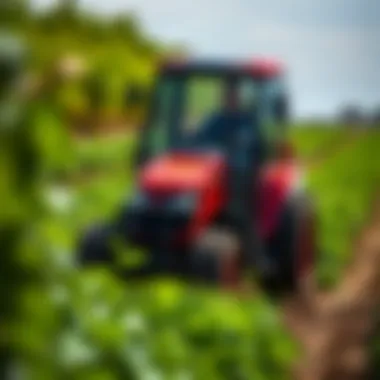
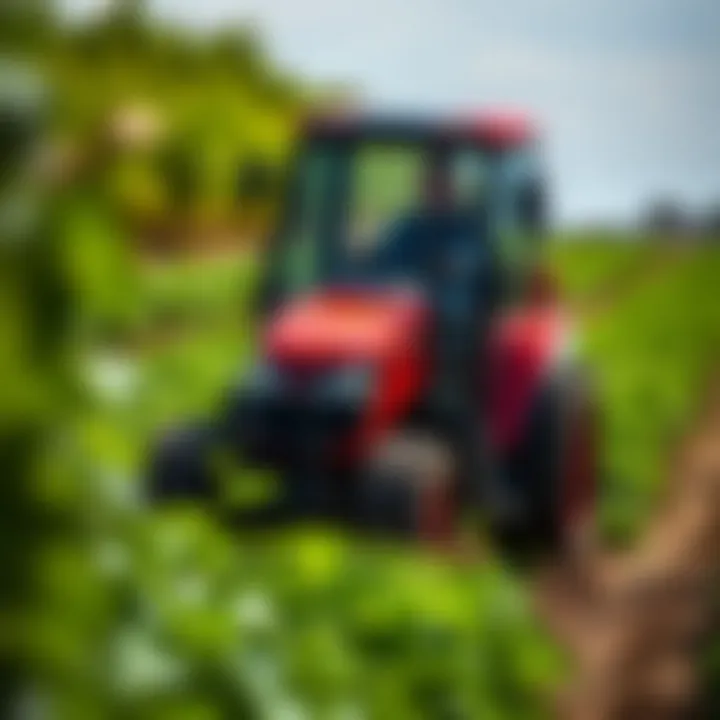
Intro
The used Toro Workman stands as a symbol of adaptability in the realm of agricultural machinery. Farmers and horticulturists alike have found the vehicle to be more than just a utility tool; it evolves into an integral part of their operations, making the workday more efficient and effective. Understanding how this vehicle accomplishes various tasks within the industry is crucial for anyone considering incorporating it into their practices.
Key Insights
Overview of the Topic
The Toro Workman is designed with flexibility at its core. Its robust build and multifunctional capabilities allow it to navigate diverse terrains and handle an array of tasks, whether it be transporting goods, towing equipment, or assisting in maintenance duties. This vehicle has been engineered to meet the diverse needs of the agricultural and horticultural sectors, and its used nature often makes it a more budget-friendly option compared to brand new machines, which is a significant consideration for many operators.
Importance in Agriculture/Horticulture/Agronomy
In today's agricultural landscape, efficiency is key, and the Toro Workman plays a pivotal role in enhancing this efficiency. It offers several benefits, such as:
- Versatility: Capable of performing multiple tasks, which reduces the need for additional machinery.
- Cost-Effectiveness: As a used vehicle, it often comes at a lower price point, making it accessible for smaller farms as well as larger operations.
- Durability: Built to withstand harsh working conditions common in agricultural settings.
- User-Friendly: Easy to operate, which is a significant advantage for those who may not have extensive machinery training.
Understanding these attributes positions users to make informed decisions regarding their equipment investment.
"In the evolving world of agriculture, having adaptable tools can make all the difference."
Sustainable Practices
Eco-Friendly Techniques
Using the Toro Workman aligns with the shifting focus toward sustainability in agriculture. Its design supports eco-friendly practices in several ways:
- Reduced Soil Compaction: Due to its lightweight construction, it prevents excessive soil pressure, promoting healthier soil for crop growth.
- Efficient Fuel Use: When well-maintained, the Workman optimizes fuel consumption, reducing greenhouse gas emissions.
Case Studies on Sustainability
For example, a local farm in California reported that by integrating the used Toro Workman into their daily operations, they were able to minimize their fuel costs by nearly 20% per season. Moreover, this vehicle enables them to carry out their tasks with a lower environmental impact, aligning with modern sustainable farming practices.
Tools & Resources
Essential Equipment and Technologies
Incorporating the Toro Workman into operations requires an understanding of compatible tools and technologies. Some essential items include:
- Attachments: Utilize different attachments like spreaders and mowers to maximize functionality.
- Maintenance Tools: Basic tools for regular upkeep can extend the lifespan of the vehicle.
Recommended Books and Readings
To gain deeper insights into effective practices, consider resources such as:
- Principles of Sustainable Agriculture by Garrison S. T. Shrobshnner
- Agricultural Machinery: Fundamentals, Technology and Applications
Each of these readings serves to enhance understanding and provide further context to the discussions around machinery and productivity in agriculture.
By incorporating a used Toro Workman into your farming approach, you not only gain resilience and productivity but also contribute to a more sustainable future in agriculture.
Intro to the Used Toro Workman
When it comes to tackling the various demands of agricultural and horticultural work, few vehicles have the adaptability of the Toro Workman. This machine has made its mark in fields, parks, and residential landscapes alike, with its versatility earning it a spot in the hearts of many professionals in these industries. The used Toro Workman brings not only functionality but also cost-effectiveness, making it an intriguing option for those looking to expand their fleet without breaking the bank.
In this section, we'll explore the foundation of the Toro Workman, delving into its historical background and the overarching characteristics that define the series. Understanding these elements is pivotal for anyone considering its use, as they highlight not just what makes the Toro Workman stand out, but also how it fits seamlessly into various operational needs.
Historical Context
The Toro Company has been a known name in the landscape and turf care machinery sector since its inception. Founded way back in 1914, Toro initially focused on innovative designs primarily for golf courses and lawns. The introduction of the Toro Workman series began in the mid-1990s, aiming to meet the rising need for utility vehicles that could handle diverse tasks on golf courses, sports fields, and beyond.
Over the years, the design and technology of the Workman have evolved significantly. Early models laid the groundwork for the series, emphasizing durability and a simple operation. As demands grew, Toro adapted, integrating features such as improved engine performance and load capacities, catering to evolving agricultural practices. Witnessing both technological advancements and consumer needs over the decades, the Workman has turned into a trusty partner for many in the field.
Overview of the Toro Workman Series
The Toro Workman series consists of a variety of models, each tailored for specific applications. These vehicles are not just about moving things from point A to point B; they're designed to excel across multiple scenarios. Key traits that define this series include:
- Flexibility: With options for different attachments, the Toro Workman can transform from a turf maintenance vehicle to an all-purpose utility transport in no time.
- Reliability: Known for their robust construction, these machines are built to withstand the rigors of agricultural tasks, providing peace of mind for users.
- User-Friendly Design: The intuitive controls and ergonomic seating make operation straightforward, even for those who may not have extensive machinery experience.
- Fuel Efficiency: With varying engine types, some models offer impressive fuel economy, which can lead to substantial savings over the machine's life cycle.
The Toro Workman has become synonymous with versatility, capable of handling everything from basic maintenance duties to complex landscape management tasks. Its ability to adjust to various roles makes it an indispensable asset for many.
"A tool that adapts to the job is worth its weight in gold; that's precisely what the Toro Workman offers."
As we journey deeper into this article, we’ll dig into its core features and the multitude of ways these vehicles can enhance agricultural and horticultural operations.
Core Features of the Used Toro Workman


Understanding the core features of the used Toro Workman is essential for anyone who is considering this vehicle for agricultural or horticultural applications. These features not only enhance its functionality but also ensure that it aligns well with the demands of diverse tasks on the field. Evaluating these aspects can greatly influence the decision-making process for potential buyers, as a clear understanding of capabilities leads to better utilization of the machine.
Engine Specifications
A powerful engine is at the heart of the Toro Workman, ensuring reliability and performance. These vehicles often come equipped with a gasoline engine, typically a 24 hp Kohler engine, which provides both strength and efficiency. The engine's horsepower allows for strenuous tasks, such as hauling materials or towing trailers, without a hitch. Additionally, the engine's design emphasizes fuel efficiency, making it a cost-effective option in the long run. With an operational simplicity that appeals to users of all skill levels, the Toro Workman offers accessible power for agricultural needs.
Load Capacity and Performance
When it comes to load capacity, the Toro Workman is built to tackle a range of tasks, boasting a load capacity of around 2,000 pounds, depending on the model. This impressive load-bearing ability is critical for those involved in grounds maintenance or landscaping. The ability to transport large quantities of materials efficiently saves both time and fuel, translating into significant overall savings. Furthermore, combined with a robust suspension system, this vehicle excels in varying terrains, ensuring that operations are not hampered by bumpy or uneven ground.
Maneuverability and Design
Maneuverability is another cornerstone feature that marks the Toro Workman as a standout choice in utility vehicles. Its compact design, usually around 54 inches in width, allows for easy navigation through narrow pathways and tight spaces. This makes it particularly useful in orchards or vineyards where space can be limited. Moreover, the dual-joystick steering system adds a layer of intuitive handling, making it easy for operators, even novices, to control the vehicle with precision. Coupled with its durable frame constructed from high-quality materials, the Toro Workman is designed to endure the rigors of everyday use while providing an impressive balance between sturdiness and agility.
"With its powerful engine, good load capacity, and agile design, the Toro Workman offers reliable solutions for diverse agricultural tasks."
In summary, the core features of the used Toro Workman, particularly its engine specifications, load capacity, and maneuverability, highlight not only its functional versatility but also the practical advantages it provides for users engaging in various agricultural tasks. Understanding these features can help potential buyers appreciate why this utility vehicle has maintained its standing in the industry.
Benefits of Using a Used Toro Workman
When it comes to operational efficiency in agriculture and horticulture, the benefits of leveraging a used Toro Workman stand front and center. This utility vehicle brings an array of advantages that resonate with the working realities of farms and gardens. From economic considerations to its adaptability in various tasks, the Toro Workman proves to be a valuable companion for farmers and horticulturalists alike. In this section, we’ll break down these benefits into three core areas, ensuring a comprehensive exploration of why this vehicle is worth considering.
Cost Efficiency
One of the most compelling reasons to consider a used Toro Workman is its cost efficiency. New utility vehicles can carry hefty price tags, often leading to a significant hit on any budget. In contrast, opting for a used model presents a much lighter financial burden.
- Initial investment: A used Toro Workman typically costs a fraction of the new price, offering savings that can be redirected towards other operational needs. This can be particularly important for those just starting out or managing tight budgets.
- Depreciation: New vehicles depreciate quickly, losing value as soon as they’re driven off the lot. However, purchasing a used vehicle allows buyers to avoid steep initial depreciation.
- Maintenance Costs: While the notion might strike fear, many used models come with robust reliability if properly maintained. Investing in routine maintenance can extend the lifespan of the vehicle. Thus, the total cost of ownership remains favorable.
"Investing in used equipment is often wiser, allowing funds to be allocated elsewhere in the business."
Versatility Across Tasks
The adaptability of the Toro Workman is nothing short of impressive. It’s not just a vehicle; it’s a multi-tool on wheels. Farmers and landscapers can deploy this utility vehicle across a variety of applications, thereby streamlining operations.
- Adaptable attachments: Whether it’s hauling materials, moving supplies, or even acting as a mobile workstation, the Workman can switch gears effectively. Attachments can change its function according to the task at hand, from mowing lawns to transporting tools.
- Terrain capability: This vehicle is equipped to handle diverse environments, whether that layout is a muddy farm in spring or a dusty field in summer. It climbs hills, maneuvers tight spots, and handles heavy loads effortlessly.
- Task management: With its variety of configurations and implements, the Workman allows for efficient workflow. Users can manage multiple tasks, avoiding the bottlenecks commonly seen in single-function vehicles.
Ideal for Various Environments
The Toro Workman’s design is centered around versatility, making it suitable for a range of environments, which is invaluable considering the diverse operations in agriculture and horticulture.
- Field work: In the wide-open fields of farming, the Workman offers durability and stability. Whether it’s taking care of crop management or transportation of seeds, this vehicle is up to the challenge.
- Urban landscaping: When it comes to maintaining urban green spaces, the Toro Workman excels due to its compact size and agility. Navigating through city parks or residential neighborhoods is a breeze.
- Commercial applications: Those operating in commercial settings—from golf courses to sports fields—find the Workman invaluable. Its capacity to serve multiple functions, such as pruning assist and debris clearance, enhances its appeal in commercial landscaping.
In summary, the Toro Workman stands as a testament to efficient and effective operation within agricultural and horticultural environments. Its cost efficiency, versatility across various tasks, and suitable design for all kinds of settings make it a solid investment for anyone looking to enhance their operational capabilities.
Common Applications in Agriculture and Horticulture
Understanding the multifaceted applications of the used Toro Workman in agriculture and horticulture is essential to grasp its true value. This vehicle is not just for transporting materials; it plays a pivotal role in enhancing efficiency and effectiveness in various aspects of fieldwork. The versatility of the Toro Workman allows for a seamless transition between tasks, from grounds maintenance to complex landscape management, making it an indispensable asset for farmers and landscapers alike. Here, we will delve into specific applications that showcase its flexibility and the numerous benefits it brings to agricultural and horticultural environments.
Grounds Maintenance
Grounds maintenance can often seem like a never-ending task for those managing large properties or agricultural lands. The Toro Workman comes equipped with capabilities that serve this purpose exceptionally well. It provides a robust platform for transporting tools, equipment, and materials to maintain grass, trees, and other landscaping features.
Some of the advantages of using a Toro Workman for grounds maintenance include:
- Time Efficiency: With its powerful engine and spacious load capacity, you can quickly move around various sections of your property without wasting precious hours.
- Adaptive Features: Attachments for tasks like mowing, leaf collection, or even aerating can be easily fitted, allowing the vehicle to handle multiple jobs efficiently.
- Operator Comfort: Good ergonomics and straightforward controls mean that operators can carry out maintenance prolonged periods without undue strain.
In essence, the Walkman becomes not only a utility vehicle but also a trusted partner in ensuring that ground conditions remain optimal for both aesthetic and agricultural productivity.
Landscape Management
When it comes to landscape management, the Toro Workman stands out as a versatile piece of equipment. Whether you're looking at residential properties, parks, or larger agricultural land, managing landscapes involves a multitude of tasks that require both precision and power.
The beneficial aspects of employing this utility vehicle in landscape management include:
- Versatile Attachments: The Workman can be outfitted with various attachments tailored for specific tasks, such as seed spreading, soil sampling, or even turf rolling. This adaptability allows it to serve different roles on the same project.
- Improved Mobility: Navigating through far-reaching landscapes can often be cumbersome. The Workman's compact build and superior maneuverability allow operators to access tight spaces that larger vehicles may struggle with.
- Increased Productivity: Its ability to perform different landscaping functions reduces the need for multiple machines, thereby saving both time and money. This leads to a significant overall boost in productivity, especially for landscaping firms managing multiple sites.
This vehicle not only simplifies traditional landscape management tasks but also enables innovative project implementations that can enhance the beauty and functionality of outdoor spaces.
Material Handling
Material handling is a critical aspect of any agricultural operation. From transporting soil and fertilizer to shifting harvested crops, efficiency in moving these materials can significantly impact productivity.
Utilizing a Toro Workman for material handling presents several advantages:
- Robust Load Capacity: With a significant load capacity, this vehicle can handle heavy loads, reducing the number of trips needed to transport materials, thus saving time.
- Stability and Control: Designed with a focus on stability, the Workman can navigate uneven terrain without compromising load safety. This feature is crucial in agricultural environments, where the landscape can be unpredictable.
- Flexible Configurations: The ability to change attachments means the Toro Workman can be transformed to suit whatever material handling task is at hand, be it a dump box, flatbed, or other custom setups.
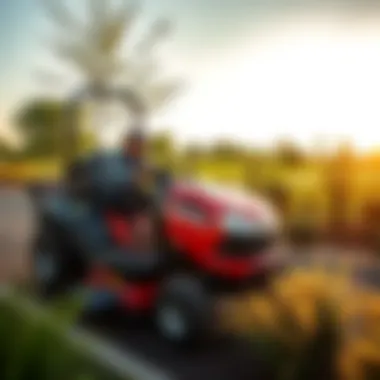
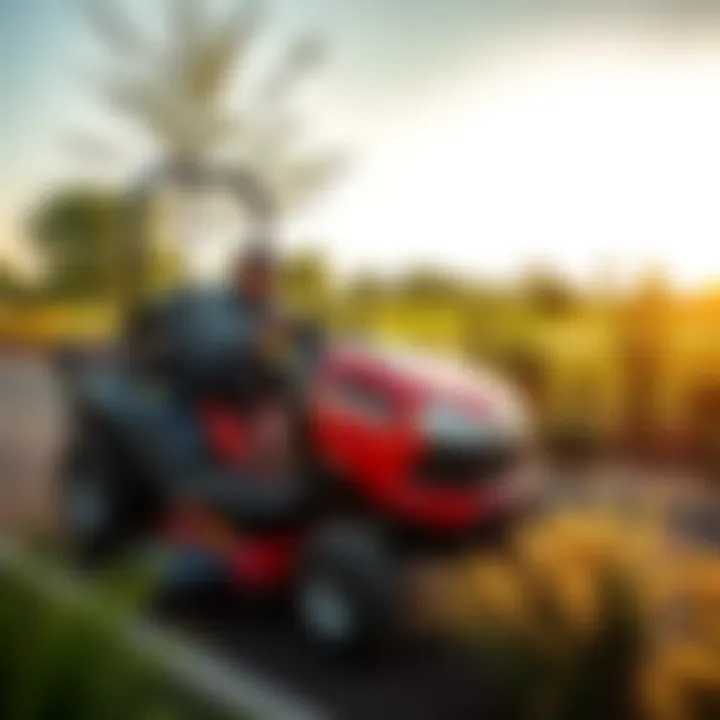
In summary, when looking at the scope of material handling, the used Toro Workman stands out as a dependable choice, capable of optimizing workflow and ultimately enhancing operational success in agriculture and horticulture.
By integrating the Toro Workman into daily operations, agricultural and horticultural professionals can simplify their workload, enhance productivity, and gain greater control over their tasks.
Understanding Maintenance and Care
Maintenance is the backbone of any machinery, and the used Toro Workman is no exception. Regular upkeep not only ensures optimal performance but also extends the life of the vehicle, making it a wise investment for agricultural and horticultural endeavors. From farmers managing vast ranches to landscape enthusiasts maintaining gardens, understanding how to care for this utility vehicle is fundamental.
Here are some specific elements to consider:
- Regular Inspections: A routine check-up can catch minor issues before they snowball into major headaches. This means taking a good look at the engine, hydraulic system, and tires.
- Fluid Checks: Keeping an eye on engine oil, hydraulic fluids, and coolant levels is necessary. Just like with humans, proper hydration and lubrication keep the Toro Workman running like a well-oiled machine.
- Cleaning Protocols: Dirt and debris can accumulate quickly on any work vehicle. Regularly cleaning out the engine compartment and undercarriage prevents corrosion and extends the equipment’s lifespan.
This foundational understanding of maintenance can lead to numerous benefits, such as reduced downtime, better fuel efficiency, and improved resale value.
Routine Maintenance Tasks
Routine maintenance tasks are straightforward but crucial. They transform into a pattern of habits that ensure your machine is always ready for the task at hand. Here are some specific actions to incorporate into your maintenance routine:
- Engine Oil Changes: Change the oil every 100 hours of operation or at least once a season, whichever comes first. This fresh oil helps keep everything running smoothly.
- Air Filter Replacement: A clean air filter enables the engine to breathe better, so it’s wise to check it after every 50 hours of use.
- Tire Pressure Monitoring: Proper tire pressure is essential for both performance and safety. Monitor this regularly, especially during seasonal changes when temperatures fluctuate.
- Greasing Points: Making sure to grease all key points as part of your routine can significantly reduce wear and tear. This is like giving your Workman a nice spa day.
Following these tasks consistently will help avoid surprises in the field.
Identifying Common Issues
Even with diligent maintenance, some issues may arise as time goes by. Knowing what to look out for can help in early detection and problem prevention. Some common red flags to keep an eye on include:
- Unusual Noises: If your Toro produces strange sounds like rattles or grinding, it’s often an indication that something is amiss.
- Loss of Power: If you feel a noticeable dip in performance, it could be a sign of engine troubles or clogged filters. Get to the bottom of it quickly to avoid further complications.
- Unpredictable Handling: If the vehicle starts to feel wobbly or unsteady, it might be a tire or suspension issue needing attention.
- Fluid Leaks: Spotting pools of fluid under the vehicle isn’t normal. Swiftly diagnose leaks to avoid extensive damage.
Being proactive and knowing how to identify these common issues can save you plenty of time and money in repairs.
Best Practices for Longevity
Longevity is something every user strives for with their Toro Workman. Following a few best practices can significantly contribute to extending its operational life:
- Store Properly: When not in use, keep the Toro Workman in a sheltered place. This ensures it’s protected from the elements and reduces rust and wear.
- Monitor Operating Hours: Pay attention to the hours of operation. Just as people need rest, machines deserve downtime too.
- Documentation: Keep a record of all maintenance performed. Having a maintenance log is beneficial not just for you, but also for future buyers should you choose to sell.
- Stay Updated on Recommendations: Knowledge evolves, and so do best practices. Regularly check Toro’s official resources or forums for any updates on maintenance practices or recalls.
By adhering to these practices, you can keep the Toro Workman working like a champ for years to come.
Evaluating the Cost of Ownership
Evaluating the cost of ownership of a used Toro Workman is an essential aspect that potential buyers should consider before making a purchase. Understanding the various costs involved—not just the upfront price—allows owners to fully grasp the financial commitments and benefits this utility vehicle will bring to their operations. This section aims to illuminate the intricacies of ownership costs, and how they can impact the overall return on investment.
Upfront Costs vs. Long-term Savings
When it comes to the upfront costs of acquiring a used Toro Workman, the initial investment may seem daunting at first glance. Factors include the age of the vehicle, its specific model, and condition. However, what’s crucial to understand is how this initial outlay stacks up against potential long-term savings.
- Repair and Maintenance - Older models may demand more frequent repairs, but by investing in a well-maintained unit, you could save considerably on repair expenses.
- Fuel Efficiency - Some models offer better fuel economy than others. Selecting a more efficient model may increase upfront costs slightly, but it can pay dividends in lower operational costs.
- Depreciation - Unlike shiny new vehicles, used ones often retain their value longer due to established reliability, which means you can expect a smaller loss over time when reselling.
In summary, it’s wise to balance the upfront expenditure against perceived and actual long-term savings.
Financing Options for Acquisition
Financing options are another important piece of the puzzle when purchasing a used Toro Workman. Understanding your choices can significantly influence your decision-making process. Various pathways include:
- Bank Loans: Traditional banks offer loans with competitive interest rates. A solid credit score will usually get you better terms.
- Dealer Financing: Many Toro dealerships provide financing options tailored specifically for their vehicles. This can sometimes be more convenient but could come with higher rates.
- Leasing: For those uncertain about committing to buying, leasing could be a viable alternative. It involves lower upfront costs but be aware of mileage limits and potential return conditions.
Evaluating these financing avenues based on your financial situation is key. Remember, picking the right financing option can have a big impact on your overall cost of ownership.
Resale Value Considerations
One often-overlooked aspect of determining the cost of ownership is understanding the resale value of the Toro Workman. Its depreciation rate can greatly affect long-term finances. Consider the following:
- Brand Reputation: Toro has built a reputation for reliability and quality over the years. This enhances resale value since buyers are generally willing to pay more for trusted brands.
- Condition and Maintenance: A well-maintained Workman will have better resale prospects than one that’s been neglected. Keeping up with service and repairs pays off when it comes time to let go.
- Market Demand: Popularity in your region may also affect how quickly you sell and at what price. Researching local market trends can provide valuable insights.
"A vehicle’s resale value is not just a number; it’s a reflection of how well you’ve invested in it over its lifetime."
User Experiences and Case Studies
Examining user experiences and case studies surrounding the used Toro Workman provides valuable insights that extend beyond mere specifications and features. These narratives illustrate the real-world applicability of the vehicle, showcasing how it meets the diverse demands faced by agricultural workers and horticulturalists. From enhancing productivity to addressing unique operational challenges, user anecdotes reflect the practical benefits and considerations surrounding the workman.
The importance of incorporating user experiences lies in the authenticity they bring. Hearing firsthand how professionals leverage the Toro Workman in their daily tasks reveals patterns and trends that may not be evident from a technical standpoint. It highlights the machine’s adaptability to different environments, offering prospective buyers a clearer picture of what they can expect in practice.
Testimonials from Professionals
Seasoned professionals across the agricultural landscape provide compelling testimonials regarding the Toro Workman. For example, a groundskeeper at a major golf course notes how the vehicle significantly improved efficiency during turf management. "Before acquiring the Workman, we were limited in what we could do with smaller utility vehicles. Now, we tackle projects much faster and with less labor required,” they shared. This particular testimonial spotlights the enhanced load capacity and versatility that the Workman boasts, which can accommodate various tasks ranging from hauling heavy bags of fertilizer to transporting tools across expansive landscapes.
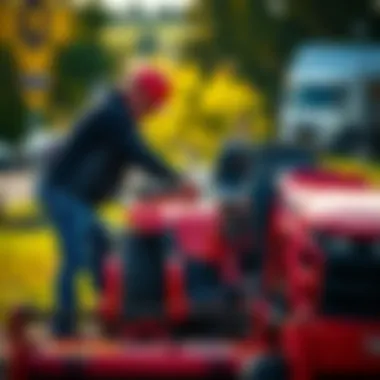
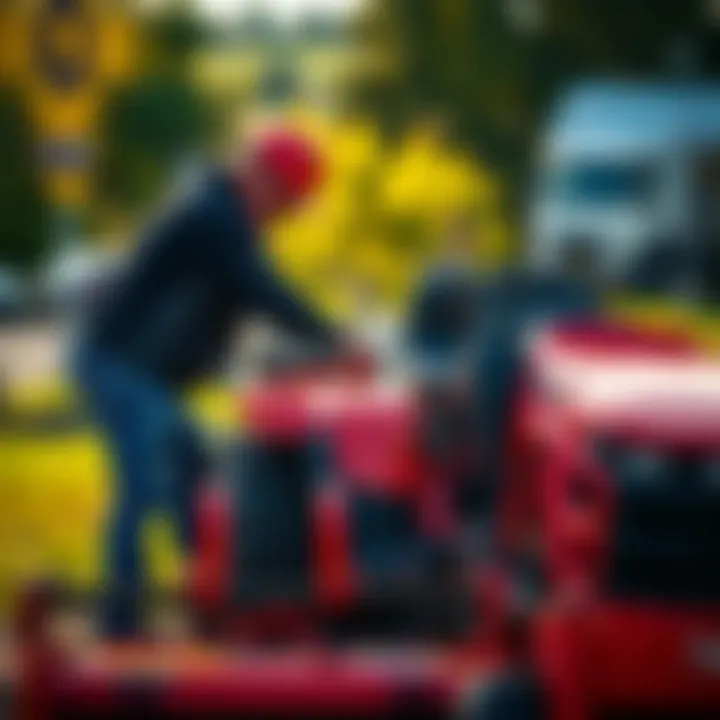
Additionally, farm owners discuss how the vehicle handles diverse terrain with ease. As one farmer put it, "With the Toro Workman, I can traverse through muddy fields without worrying about getting stuck. It's a reliable partner, especially during the spring planting rush.” Such endorsements not only validate the Workman's design features but also underscore its reliability in critical operations.
Innovative Uses in the Field
The ingenuity seen in user applications of the Toro Workman often blurs the line between ordinary functionality and innovative adaptations. For instance, a landscape architect utilized the vehicle to streamline the installation of a complex irrigation system, showcasing its capability to maneuver through tight spaces while carrying necessary equipment.
Another noteworthy example stems from a community garden initiative that used the Workman to support their sustainability goals. They modified the vehicle to include a multi-bin composter, allowing them to transport compost materials while concurrently assisting in landscaping tasks. This creative approach demonstrates how the Toro Workman is not just a utility vehicle but can serve as a versatile platform for various agricultural innovations.
Moreover, these case studies highlight the collaborative nature of using the Workman within teams. Farmers and horticulturists often work together, sharing the workload effectively.
"The Toro Workman has become an integral part of our daily operations, enhancing both teamwork and productivity during peak seasons. We can accomplish so much more in a shorter amount of time."
Comparative Analysis with Other Utility Vehicles
When considering the utility vehicle landscape, the Toro Workman stands as a formidable player, but it’s crucial to anlayze it against other vehicles in the same realm. This comparative analysis not only sheds light on where the Toro Workman excels but also where potential alternatives might fit the bill better for certain use cases. Understanding the subtleties and varying attributes of utility vehicles ultimately assists buyers in making informed decisions tailored to their specific operational needs.
Key Differentiators
In the crowded utility vehicle market, several characteristics distinguish the Toro Workman from its competitors:
- Design Philosophy: Toro's emphasis on rugged yet versatile design sets it apart. Its modularity allows users to easily adapt it to different tasks, something that may not be as streamlined in other brands.
- Engine Efficiency: Equipped with robust engines, the Workman offers commendable power without compromising fuel efficiency. Compared to alternatives like the John Deere Gator, which may offer similar power options but less fuel economy, the Toro Workman often turns out to be the more cost-effective choice in the long run.
- Available Attachments: Another notable difference lies in the attachment options. The Toro Workman can accommodate a range of attachments for varied applications, while many competitors may have restrictive or limited attachment capabilities. This adaptability is particularly beneficial for farmers and groundskeepers who engage in a multitude of tasks throughout the year.
- User-Friendly Interface: The operating system and controls of the Toro Workman are highly intuitive. For someone unfamiliar with utility vehicles, this ease of use can speed up the learning curve significantly. Other brands, like Club Car, often have a steeper learning curve, which can hinder productivity initially.
- Service Network: Toro has a robust service network, ensuring that users have easier access to repairs and parts. This is a key consideration for anyone in the agricultural field, where downtime may significantly impact yield and workflow.
"The Toro Workman isn’t just another utility vehicle; it’s a tool that evolves with your requirements, making it invaluable in any agricultural setting."
Strengths and Limitations
While the Toro Workman is a strong contender, it has its strengths and limitations compared to other utility vehicles:
Strengths:
- Versatility: Widely used in various agricultural settings, it handles tasks ranging from material hauling to maintenance easily.
- Tough Build: Designed to withstand rugged conditions, it ensures that your investment lasts.
- Excellent Maneuverability: Its compact design allows for greater mobility in tight spaces, unlike some larger utility vehicles that can struggle in constrained areas.
Limitations:
- Price Point: Depending on the configuration and attachments, the Toro Workman can be on the pricier side. Some buyers might find alternatives like the Kawasaki Mule more budget-friendly, although they may sacrifice some versatility.
- Weight Distribution: While it's sturdy, its weight may be an issue in muddy or loose terrain, making it less ideal for all farming conditions.
- Limited Speed: For applications requiring quick transit, competitors might offer faster options that can cover ground speedily more efficiently.
In the end, weighing these differentiators against unique operational needs will highlight where the Toro Workman shines and where it may be beneficial to explore other vehicles. Every agricultural setting is unique, and understanding the individual strengths and weaknesses of utility vehicles ensures that farmers and workers select the machine that best suits their requirements.
Future Trends and Innovations
With the growing demands of modern agriculture and horticulture, the importance of recognizing future trends and innovations cannot be overstated. As industry professionals increasingly look toward sustainable and efficient practices, the Toro Workman stands at the forefront, embodying adaptability and ensuring it meets tomorrow's expectations. The focus on technological advancements and sustainability fortifies its utility in diverse environments.
Technological Advancements
The Toro Workman series is continually evolving to incorporate cutting-edge technology aimed at boosting performance while simplifying operation. One noteworthy trend is the integration of GPS and precision farming technologies. This modern approach allows for accurate navigation and data collection. As a result, farmers can enhance their workflows by making informed decisions based on real-time data.
Moreover, advancements in electric power sources are gaining traction. These systems offer not only higher efficiency but also reduced noise and emissions. The electrification of utility vehicles helps align operations with today’s environmental goals, turning the spotlight on reducing carbon footprints without sacrificing performance. Utilizing smar technology not only ensures that agricultural workers can maximize productivity but also limits their environmental impact.
The Toro Workman is also incorporating automation features. These advancements can include self-driving capabilities in the near future, which can decrease the need for manual labor, offering a far more efficient approach to routine tasks. Overall, these technological innovations represent a significant step forward in enhancing operational efficiency.
Sustainability Considerations
Sustainability is not simply a global buzzword; it's an essential priority for many in agriculture and horticulture. The used Toro Workman plays an integral role here by promoting practices that yield long-term ecological benefits.
Many models now emphasize eco-friendly operating systems. For instance, the use of biofuels has been explored, enabling operators to reduce greenhouse gas emissions while still harnessing the power and reliability of the Workman. Additionally, the emphasis on durable materials in construction prolongs the vehicle's service life, decreasing waste and the need for replacements.
Organizations can further optimize their operations by adopting sustainable maintenance practices. This includes regular checks that not only ensure the vehicle is running efficiently but also extend its life through preventative care. Good upkeep leads to fewer resources being consumed over time, aligning with broader sustainability goals.
"Sustainability is not a destination, but a journey – one that the Toro Workman embraces with every turn of the wheel."
Closure and Recommendations
In wrapping up our exploration of the used Toro Workman, it's clear that this vehicle isn't just a tool; it’s an essential partner in agricultural and horticultural tasks. The myriad of applications that the Toro Workman can fulfill speaks volumes about its versatility. This versatility is crucial for those involved in land management, groundskeeping, and landscaping. By understanding the machine's full potential, users can optimize their operations, reduce costs, and improve productivity.
Final Thoughts on the Toro Workman
The used Toro Workman represents a blend of efficiency and reliability that few utility vehicles can match. Its robust engine performance and thoughtful design make it suitable for a variety of roles, from hauling materials to precise landscape maintenance. Users often praise its easy maneuverability, especially in tight spots where larger machinery would struggle. One of the standout features is its adaptability; whether you are a farmer managing crops or a landscaper maintaining public parks, the Toro Workman can be equipped with various attachments that meet your specific needs. This flexibility ensures that you’re getting more bang for your buck, maximizing your return on investment.
"The Toro Workman has become the Swiss Army knife of my operations—all in one vehicle!"
– A satisfied landscape manager
Guidance for Prospective Buyers
When considering a purchase of a used Toro Workman, prospective buyers should take several factors into account:
- Assess Your Needs: Understand what tasks you need the vehicle for—this will guide you in choosing the right model and attachments.
- Condition Matters: Since you're looking at used models, check for wear and tear, engine condition, and any past maintenance records. A well-maintained vehicle can save you future headaches and costs.
- Operations Terrain: Consider the types of landscapes you'll be working on. Different models perform better in distinct conditions, so choose wisely.
- Evaluate Costs: Don’t just look at the upfront price. Factor in potential repairs, maintenance costs, and any attachments you might need to acquire.
- Ask for References: Speak to other users or browse discussions on platforms like reddit.com or agricultural forums to get real-world experiences.
By making informed choices, you can ensure that the Toro Workman not only meets your operational requirements but also serves as a valuable investment for many seasons to come.
For further insights, visit Wikipedia on Toro or browse Landscaping Equipment on Reddit.
Ultimately, the used Toro Workman isn't just about getting work done—it's about enhancing your overall productivity and making your operations more efficient.







